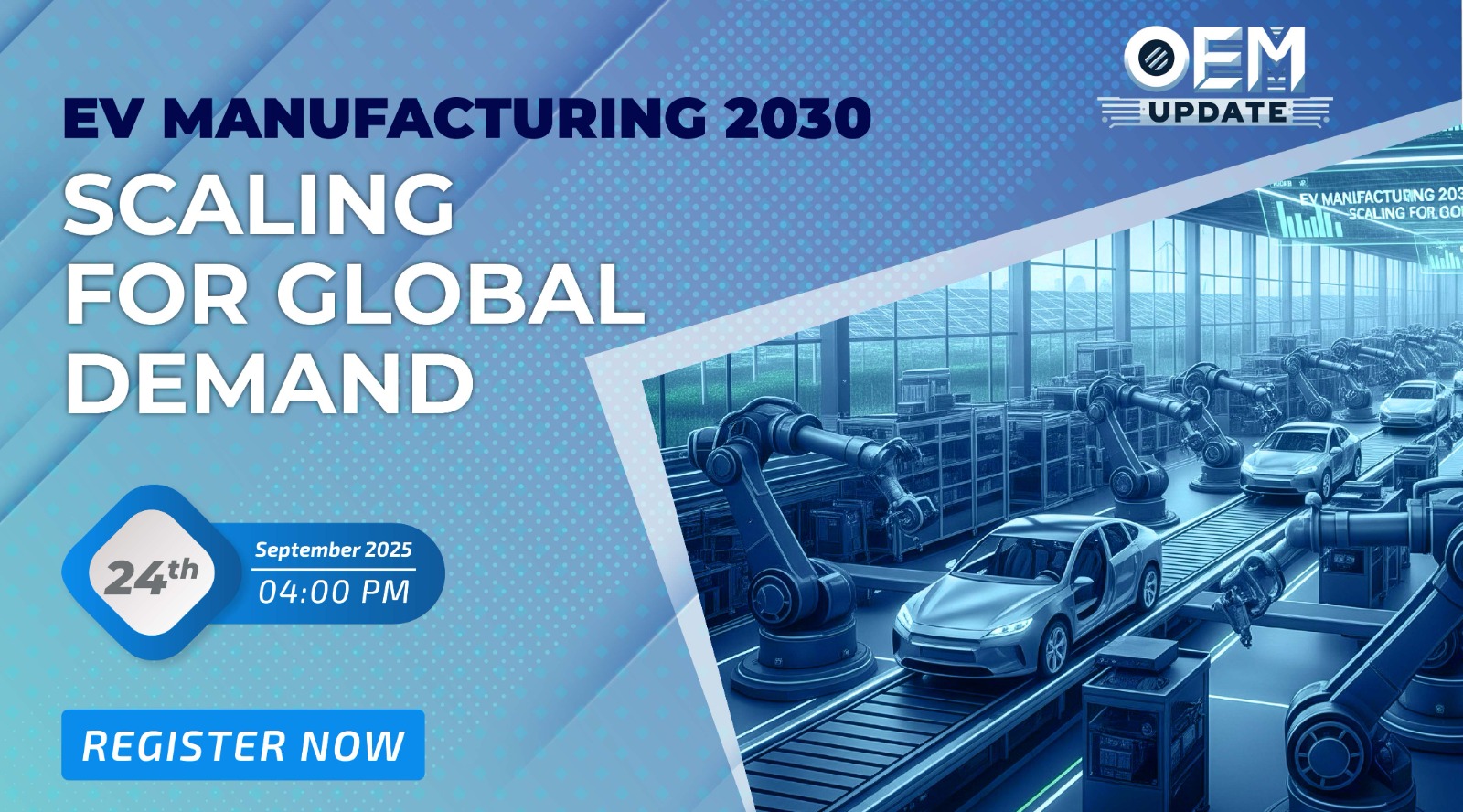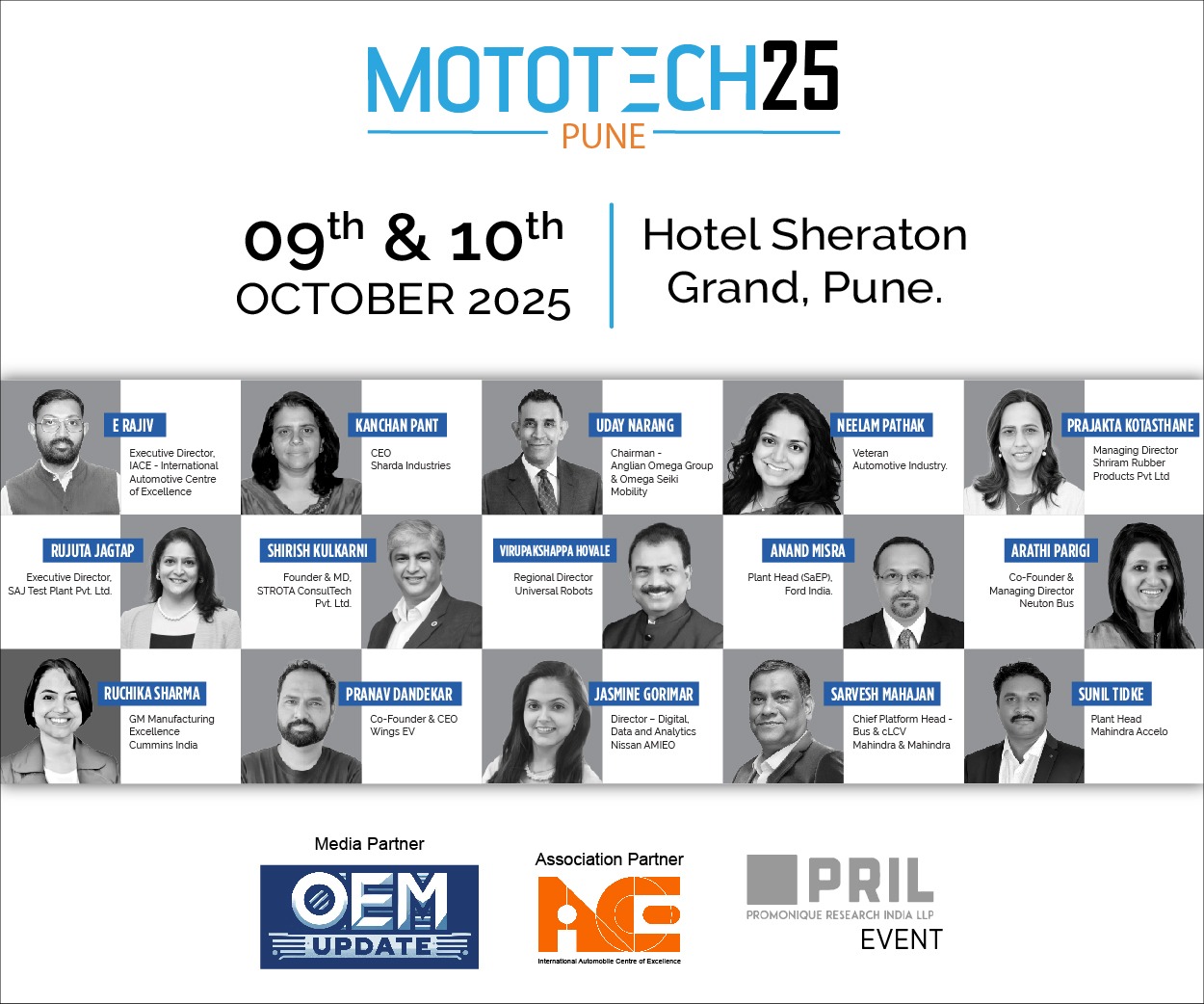Evolving third-largest Automobile industry
By OEM Update Editorial July 2, 2022 3:53 pm IST
Electric mobility is inundated with innovations in automotive industry as adoption of EV continues. Initiatives like Make in India, PLI, and zero emission vehicles are evolving to elevate country’s status as 3rd largest automobile industry; and this trend is gaining momentum.
India is shaping to be the 3rd largest automotive industry globally. It is the fifth-largest market and aims to achieve 100 per cent electrification by 2030. The World Economic Forum ranks India 30th on the global manufacturing index that assesses the manufacturing capabilities. Connectivity is still in the early stages of adoption in India. The demand for electric mobility will bring more innovations, with players like software and technology providers entering the automobile industry.
The Indian electric vehicle market, valued at USD 1,434.04 billion in 2021, is expected to reach USD 15,397.19 billion by 2027, registering a CAGR of 47.09% during the forecast period 2022-2027 according to a mordor intelligence report.
The PLI scheme would promote the domestic manufacture of electric and hydrogen fuel vehicles and boost local battery storage products for the Indian EV industry. The Government’s ease of doing business and the Make in India initiative are essential in elevating the country’s position. Through the Automotive Mission Plan 2026, the National Electric Mobility Mission Plan, and other initiatives, the Government seeks to achieve two objectives—facilitate long-term growth in the industry and reduce emissions and oil dependence.
More than 200 corporations and organisations have committed to reducing carbon emissions and have netzero carbon emissions by 2040. Climate change concerns are increasing. Elaborating on carbon emissions, Mr.Puneet Jain, Founder of Natural Battery Technologies,
says, “Some of these corporations have large vehicle fleets that must transition to zero-emissions vehicles to reach their carbon emissions targets, including heavy duty vehicles, delivery vans, buses, and other commercial vehicles.” Many corporations are setting targets to reduce greenhouse gas emissions and meet consumer demand. Besides this emission issue, the shortage of semiconductor chips slowed the pace and speed of electronics in this electrical era that caught the attention of game-changers globally in the automotive sector.
The massive shortage of semiconductors has disrupted the production of the Indian automobile industry. The crisis will likely continue this year and will impact automobile production in the country. Sounding optimistic about chip manufacturing, Mr. Arindam Lahiri, CEO of Automotive Skills Development Council, says, “Given the rate at which various applications have begun to consume semiconductors, I believe the shortage of semiconductors should have been anticipated.” However, the chip manufacturing facility is capital intensive and has a long gestation period. So, semiconductor chip manufacturing capacity enhancement is occurring in a graded fashion. It is not a gradual curve for capacity to be upgraded globally. It is common knowledge that automobiles are the third largest user of semiconductors in the world today, with the most significant users in telecom, handsets, and computers, which consume many of these semiconductor chips. Given the prediction, we will soon have excess capacity in semiconductor chips. Further, sensing how vehicles are moving today involving widespread use of semiconductor chips, the incorporation of artificial intelligence and machine learning into vehicles is also coming into force.
Mr. Rajesh Kumar Penchala, Vice President, Etrio Automobile Pvt. Ltd., stated, “Chip shortages have recently disrupted the entire supply chain. It is a significant blow, particularly to the automobile industry.” The drop in sales in the last few months is indicative not only of electric vehicles but also of automobiles and regular ICE engine automobiles. India has always had semiconductor manufacturing companies in its ecosystem, but they have yet to take shape to meet the current demand. In the past, there was not much of a market on which companies could capitalise. But now, with the sudden onset of EV adoption, companies have completely missed the bus, which led to relying heavily on some Chinese companies for imports. Today, some Indian conglomerates are working on establishing semiconductor chip manufacturing units. However, localised production of chips would also help the Indian industry grow and reduce imports of these critical components from outside India. So that is one crucial consideration.
Analysing the outcome, Mr. Rajesh clearly remarked that India needs indigenous production. Speaking about opportunities, Mr. Puneet said, “Another option is to go back to older technology when we had enough production and try to update our software and use the older hardware.” And keep on using it while expanding our manufacturing capabilities. Expanding further, he said, though chips are essential elements for EV manufacturing, in terms of battery packs for electric vehicles, protection circuits are integrated into battery management systems and communication protocols.
Batteries are the central part of EVs, and the growth in EVs demand will consequently cause an upsurge in Li-ion battery demand. According to a report by Mercom India, India’s annual battery market could surpass $15 billion by 2030, and the battery demand in India is expected to rise to 260 GWh in the ‘accelerated scenario’ by 2030.
Lithium-ion battery for electric vehicles
The lithium-ion battery delivers maximum safety, high efficiency, and longer life cycles. They surpass the lead-acid batteries across all parameters, such as high power density, deep cycling capability, and much longer service life. Further, most OEMs have started working on hydrogen since the thin layered battery has issues due to less mineral availability. Compared to a lithium-ion battery, or any other type, hydrogen is a relatively high energy-dense fuel. However, there are several drawbacks to using a hydrogen vehicle or a hydrogen fuel cell. The first and foremost disadvantage is the low efficiency of the hydrogen cell in comparison to the lithium-ion cell. Lithium-ion cells can use up to 75 to 80% of the total power generated to deliver the full power, says Mr. Puneet. Other disadvantages include the fact that they are highly flammable and difficult to integrate. It is a very advanced technology that requires more research before it can be widely adopted. So, compared to hydrogen fuel cells, lithium batteries are here to stay for a while longer.
Sounding a similar opinion, Mr. Rajesh says that the current adoption would not be feasible in terms of business. Still, if we can categorise technology aspects and the safety standards, handling these hydrogen fuel cells puts a question mark on the feasibility due to huge transportation cost, as well as the cost of producing hydrogen that needs to be filled into the tanks. That could be a significant impediment. The challenge lies in who is willing to pay for the cost of developing such technology, which is cost-effective and viable from a safety point of view. Speaking on battery safety, Mr. Puneet articulated that solid-state batteries are safer than batteries with this liquid electrolyte. “Lithium-ion batteries are currently so dangerous to use because they are not properly operated.” Solidstate batteries use a solid-state electrolyte, which eliminates the possibility of a thermal runaway due to external heat, making the batteries significantly safer than the current batteries, which contain a liquid electrolyte. Aside from that, performance improves because ions move faster in a solid-state than in a liquid state, allowing for faster charging. As a result, it is a better product. But, once again, the question of commercial development comes into the picture, whether they can be mass adopted for our current usage.
On an optimistic note, Mr. Rajesh said that commercialising hydrogen fuel cells would probably take another six to seven years. As a result, hydrogen fuel and solid-state batteries are likely to arrive simultaneously. So, at that point, it has to be decided which one is more user-friendly in terms of pricing and usage. “I believe hydrogen fuel service would win the race due to its advantages.” And besides developing technologies such as hydrogen fuel cells for EV batteries and solid-state batteries, artificial intelligence and machine learning are also finding their way to make electric vehicles smarter.
Connectivity for a smarter economy
Speaking on the scope of digitalisation, Mr. Arindam expressed that vehicle technologies use AI and machine learning applications. For example, emergency braking systems have such applications. There is predictive maintenance scheduling as well as a tyre maintenance schedule. Innovative tyres are now available, especially useful in electric vehicles, where battery weight and weight dynamics play a significant role. Tyres are a substantial part of the vehicle’s cost. Each tyre determines the lifecycle cost of the vehicle. These are some of the areas where vehicles are becoming connected. To become a circular economy, a scrappage policy is also one of the vital links. Talking further on connectivity, he says, significantly, it is a first step toward becoming a more mature automotive industry. Any large automotive market in the world has a well-developed scrappage ecosystem that revolves around scrappage, and the circular economy, particularly in the context where batteries and other electronic waste are concerned.
Supplementing the thoughts, Mr. Rajesh said, the scrappage policy significantly boosts the auto industry. So, even though sales have been stagnant in recent years, much momentum has been witnessed with the production of new vehicles. He says, “I believe the time has come for a vehicle scrappage policy to be implemented, which will pave the way for newer vehicles, primarily electric vehicles.” And the EV industry is rapidly expanding with government policy and initiatives to promote clean energy and reduce dependence on oil.
Initiatives for decarbonisation
It’s high time the Government must develop new and innovative initiatives that may help open ways for a circular economy, including decarbonisation, which may help reduce emissions and oil dependence. While EVs minimise pollution in the places they operate, the broader decarbonisation will happen only when the electricity from the socket is clean. This is not in the scope of EVs. However, EVs help reduces dependence on oil since oil plays a minimal role in power generation. The Indian Government seems to be encouraging battery-swapping to standardise batteries and reduce dependency on charging infrastructure. Elucidating his point, Mr. Kalyan C Korimerla stated, “We will have to wait and see how technologies such as fast charging will play a role in going forward, and what will be the eventual winner in the marketplace; over the long run.” In the distant future, green hydrogen will play a key role in reducing dependence on oil imports, especially in the transportation sector of large commercial vehicles.
Shaping third-largest automotive industry globally
Indian manufacturers and refineries must start building products suitable for Indian climate conditions. Self-reliance in LithiumIon battery manufacturing is necessary. Localised production could lower the price of the batteries, and Indian research centres can discover novel ways to reduce imported minerals required to synthesise the batteries. With the power of research and innovation, Indian manufacturers can continue feeding the demand for high performance and safe batteries. Moreover, a robust vehicle financing environment is crucial in enabling India to achieve this goal. At present, even the public sector banks are not actively financing EVs. However, the Government must design policies and encourage public sector banks and large financial institutions to support EV financing.
The second most important area is to extend FAME subsidies. Due to recent disruptions in supply chains and an increase in the commodities cost, the long-anticipated declining price curve for Li-ion batteries has been disrupted in recent months. In addition, the cost of several vital components has gone up significantly. Furthermore, the Government’s push for localisation without adequate capacity has led to increasing the cost of powertrains, making it challenging for smaller EV start-ups to manage expenses. Suffice to mention, most of the innovations originate from start-ups. Hence, the Government must extend Faster Adoption of Manufacturing of Electric Vehicles (FAME) subsidies.
The way to future
Today big companies are investing in electric vehicle manufacturing in India. If developments are any indication, market trends are transitioning toward EV manufacturing, including charging infrastructure. Even though 2-wheelers dominate the current EV volumes, EV manufacturing has caught up quite a bit in the last two years, with close to 4 lakh 3-wheeled vehicles sold in 2021-22. India’s 2030 ambition can only be achieved by a collective effort from automotive players and new-age start-ups that require financial schemes to augment production capacities. Schemes like PLI and Advanced Chemistry Cell (ACC) encourage companies to set up plants in India to cater to electric and hydrogen fuel vehicles.
The adaptive way is correction and reform. This PLI scheme for ACC (₹18,100 crores) along with the already launched PLI Scheme for the automotive sector (₹25,938 crore) and FAME (₹10,000 crores) will enable India to leapfrog from traditional fossil fuel-based automobile transportation system to environmentally cleaner, sustainable, advanced and more efficient Electric Vehicles (EV) based system.
Today, the increase in demand for EVs due to a favorable regulatory framework attracts investment in this sector. The country still needs to make significant investments to completely localise most of the critical components so that the reliance on imports decreases
significantly. Robust charging infrastructure is required to facilitate the mass adoption of EVs. India’s stellar progress as a world-class manufacturing destination resonates strongly with the call of Atmanirbhar Bharat – a self-reliant India shaping India into the 3rd largest automobile industry. It’s a tall order reckoning the facts, and that’s ultimately what the industry expects.
Cookie Consent
We use cookies to personalize your experience. By continuing to visit this website you agree to our Terms & Conditions, Privacy Policy and Cookie Policy.
















